Introduction
What is Fiber, and Why Do We Need it?
How Much Fiber Do We Actually Need?
Fiber and Health: What the Science Says
The Trend Factor: Why it is Popular Now
Top Fiber-Rich Foods
Is There Such a Thing as Too Much Fiber?
References
Further Reading
Discover how increasing dietary fiber supports better digestion, heart health, weight management, and overall longevity, plus practical tips for adding more fiber-rich foods to your daily routine.
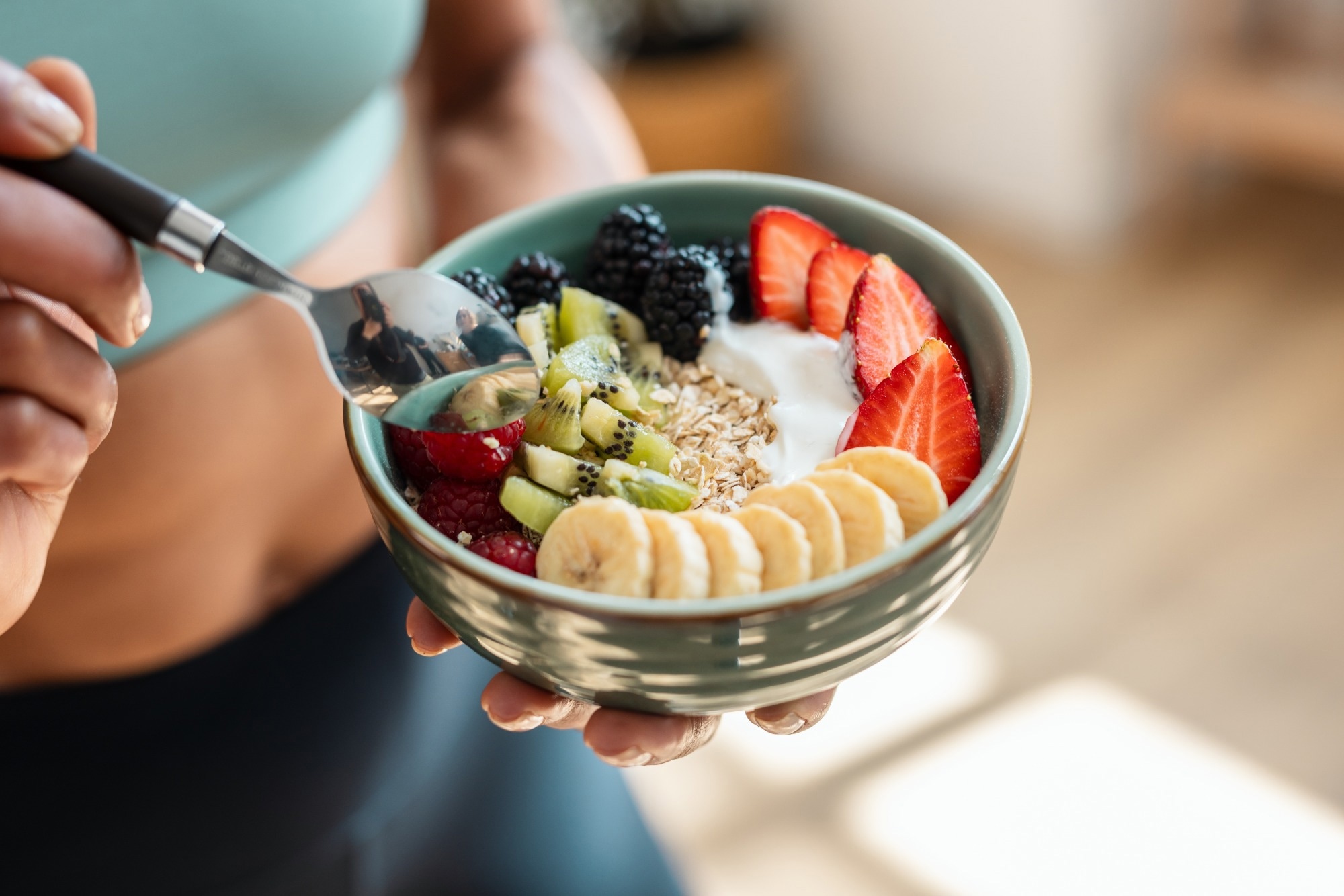 Image Credit: Joseph Suria / Shutterstock.com
Image Credit: Joseph Suria / Shutterstock.com
Introduction
From improving digestion and heart health to regulating blood sugar and promoting longevity, fiber plays a vital role in disease prevention. This article explains what fiber is, its types and health benefits, why most people do not consume enough fiber in their diet, and how this essential nutrient supports digestion, heart health, weight control, and longevity.
What is Fiber, and Why Do We Need it?
Dietary fiber refers to carbohydrate polymers that are resistant to digestion in the small intestine. Insoluble fiber, like cellulose, adds bulk to stools and aids bowel movements, whereas soluble dietary fiber (SDF) dissolves in water and is rapidly fermented by gut microbiota, which subsequently produce beneficial short-chain fatty acids (SCFAs).1,4
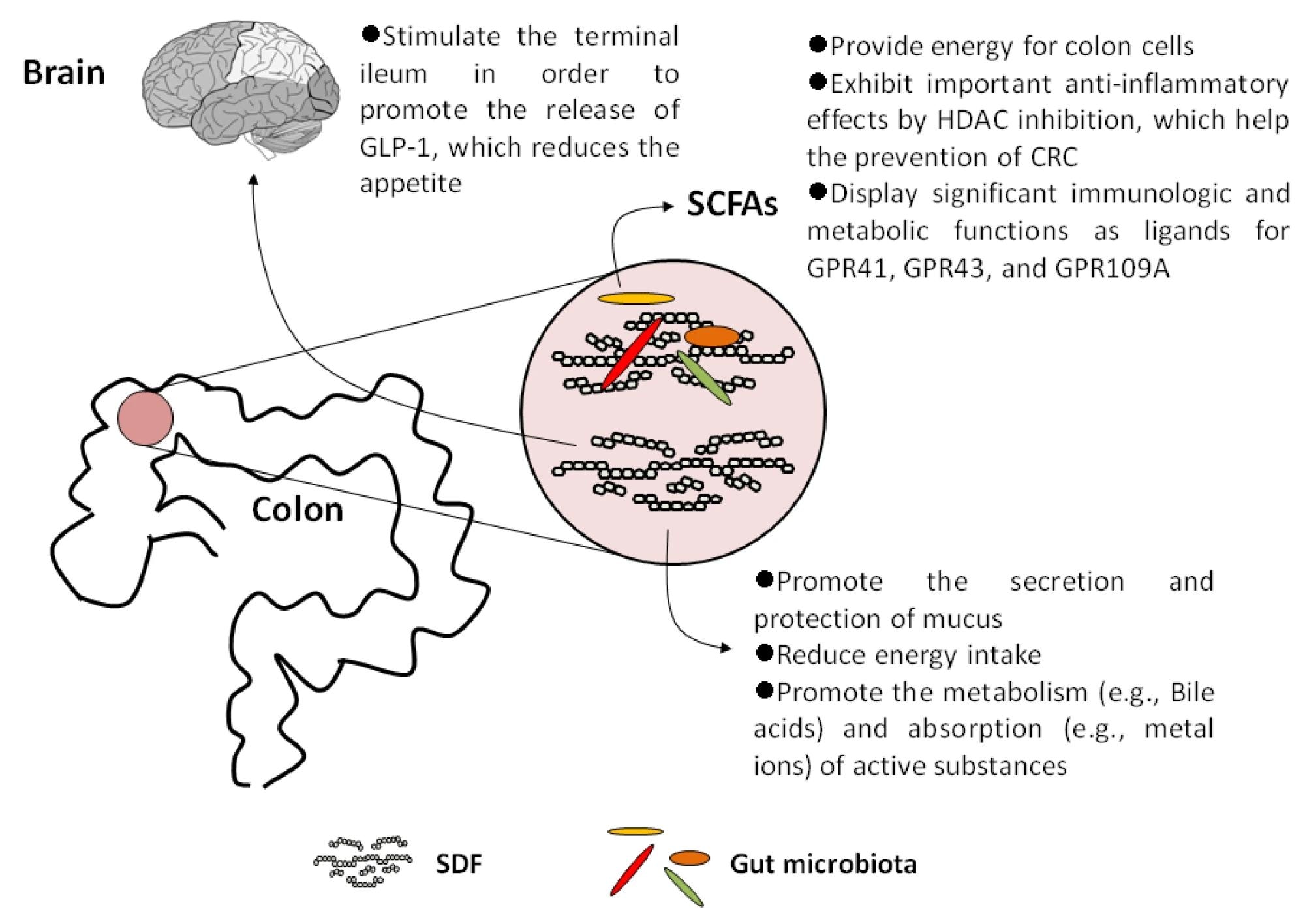 Summary of identified physiological effects of SDF and SCFAs on human health.1
Summary of identified physiological effects of SDF and SCFAs on human health.1
SDFs include resistant oligosaccharides like fructo-oligosaccharides and galacto-oligosaccharides, viscous fibers including pectin, β-glucan, and gums, as well as chemically modified fibers like methylcellulose and resistant starch type 4.
SDFs regulate digestion by improving stool consistency and promoting intestinal transit. These fibers also act as prebiotics by fostering the growth of beneficial gut bacteria such as Bifidobacteria and Lactobacilli, thereby enhancing microbial diversity and immune health.1,4
SDFs help control blood sugar and cholesterol levels by slowing glucose and lipid absorption. Additionally, these fibers stimulate the release of glucagon-like peptide-1 (GLP-1), which improves satiety and insulin sensitivity.
By promoting fullness and reducing calorie intake, SDFs support weight management and may reduce the risk of obesity and type 2 diabetes mellitus. SCFAs derived from SDF fermentation are also involved in inflammation control and gut barrier protection, thus highlighting the critical role of fiber in overall health.1,4
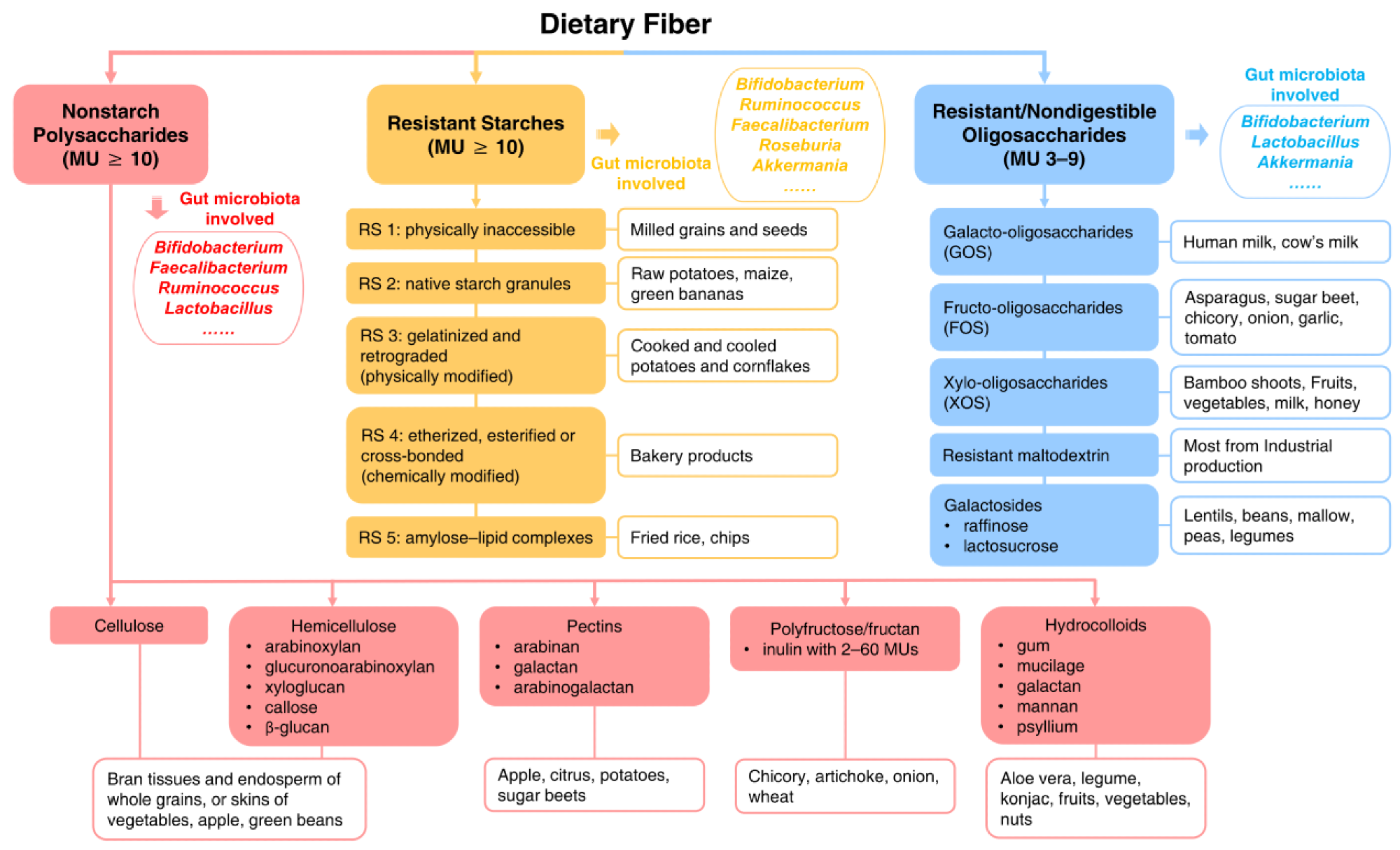 Type of dietary fiber. MU: monomeric unit.4
Type of dietary fiber. MU: monomeric unit.4
How Much Fiber Do We Actually Need?
Health organizations recommend that adults consume between 25 and 30 grams of dietary fiber every day to maintain digestive health and reduce the risk of chronic disease. Despite these guidelines, actual intake of fiber remains low, with adults in North America consuming an average of 17 grams of fiber every day.
In comparison to modern eating patterns, ancestral diets may have included up to 100 grams of fiber per day from a wide variety of unprocessed plant foods. Today, people often struggle to identify high-fiber choices, may not recognize the fiber content in whole grains, or intentionally avoid carbohydrate-rich foods based on popular diet trends. Furthermore, the widespread consumption of processed and refined foods, which are low in fiber, as well as the lower intake of whole plant-based foods such as fruits, vegetables, legumes, nuts, and whole grains, also contributes to reduced fiber intake.2
Replacing refined grains with whole grains, including a daily serving of legumes, and incorporating fiber-rich seeds like flax or chia into meals can improve fiber intake. Reading nutrition labels and choosing “high fiber” foods can also guide healthier choices. Increasing fiber intake from whole foods is also an effective way to support gut health, manage weight, and reduce disease risk.2
Your Gut Loves Dietary Fiber | The Science of Digestion
Fiber and Health: What the Science Says
Scientific evidence consistently supports the health benefits of dietary fiber across various organ systems.
For digestive health, fiber increases stool bulk and improves bowel regularity, thereby reducing constipation and the risk of gastrointestinal disorders, such as diverticulitis. By promoting microbial diversity and producing beneficial SCFAs during fermentation, fiber supports a healthy gut environment.3
Fiber, particularly soluble types such as β-glucan, has also been associated with cardiovascular benefits, as its intake can reduce low-density lipoprotein (LDL) cholesterol levels by binding to bile acids and reducing cholesterol reabsorption. Fiber also slows the digestion and absorption of carbohydrates, thereby leading to improved blood glucose control and insulin sensitivity. This is particularly relevant for individuals with or at risk of type 2 diabetes mellitus.3
High-fiber diets also aid in weight management, as fiber-rich foods increase satiety by slowing gastric emptying and promoting the release of appetite-regulating hormones, which can help reduce overall calorie intake. Several studies have also reported an inverse association between fiber intake and colorectal cancer risk, which is likely due to the role of fiber in reducing intestinal transit time and modulating inflammation.3
Increased fiber consumption has also been associated with reduced all-cause mortality, which is likely attributed to the cumulative protective effects of fiber intake on metabolic, cardiovascular, and immune functions. Overall, increasing fiber intake from a variety of whole foods is a simple yet powerful strategy to enhance long-term health and longevity.3
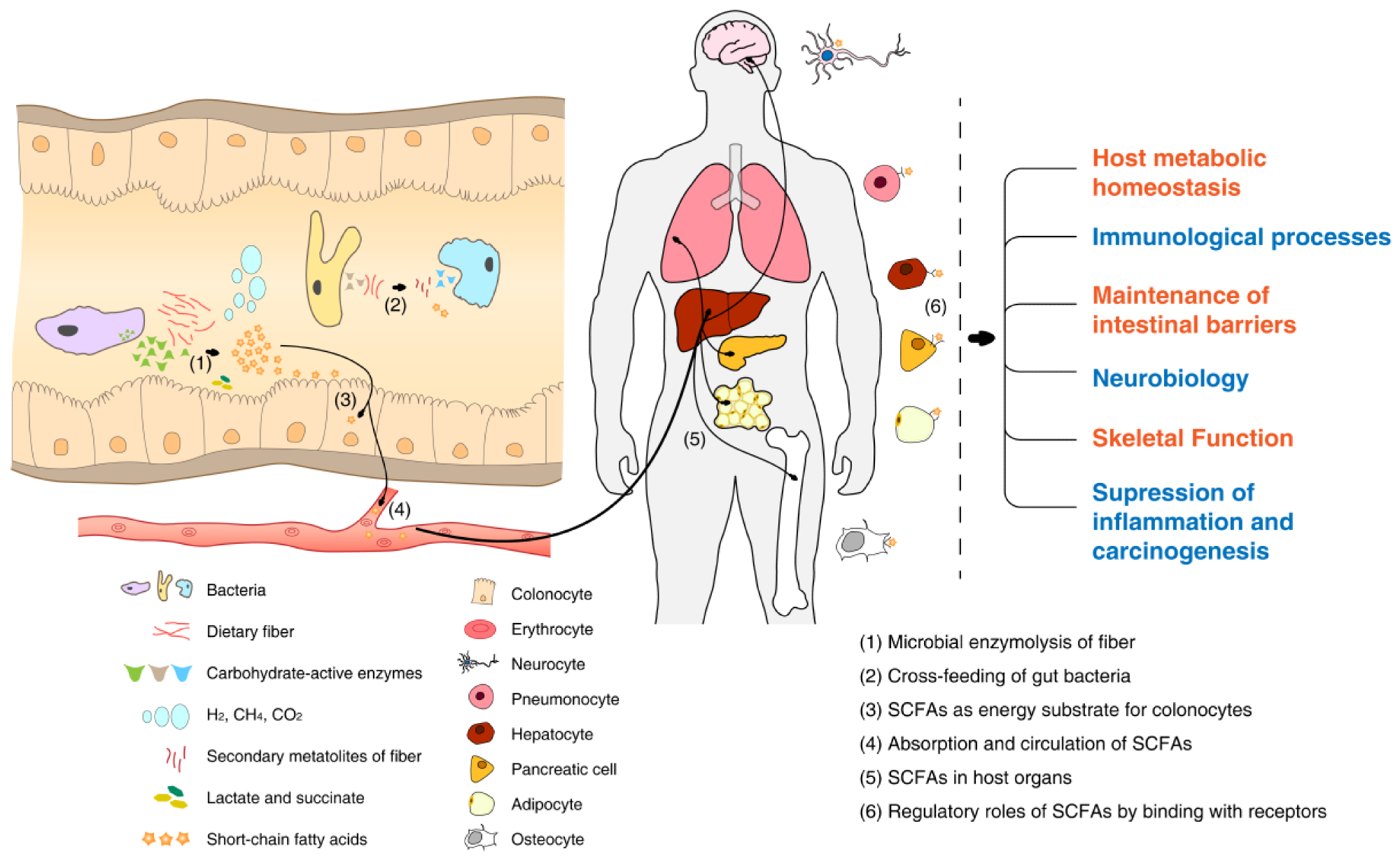 Fermentation of dietary fiber by gut microbiota.4
Fermentation of dietary fiber by gut microbiota.4
The Trend Factor: Why it is Popular Now
Fiber has become increasingly popular due to growing awareness of gut health and advances in microbiome research. Recently, plant-based and Mediterranean diets, both of which naturally include high-fiber foods like vegetable, fruits, legumes, and whole grains, have been widely adopted for their benefits in managing weight and preventing chronic disease. Social media platforms like TikTok and Instagram have also popularized trends like the “fiber flush,” which claims to promote detoxification and appetite control.
Fiber is often recommended in dietary plans for users of GLP-1 receptor agonists, such as Ozempic and Wegovy, both of which are medications used to manage type 2 diabetes and support weight loss. Increased fiber intake is recommended in these patients to reduce gastrointestinal side effects associated with these medications and enhance satiety.4,5
Top Fiber-Rich Foods
Whole grains such as oats, brown rice, and quinoa are rich in both soluble and insoluble forms of dietary fiber. Oats and barley are particularly rich in beta-glucan, a soluble fiber known for lowering cholesterol and supporting heart health. Wheat and rye contain high amounts of arabinoxylan and cellulose, which aid digestion and promote satiety.6
Legumes, including lentils, beans, and chickpeas, also significantly contribute to fiber intake, as the high content of fermentable fibers can regulate blood sugar levels and support a healthy gut microbiome.
Fruits like apples, pears, and berries provide soluble fiber in the form of pectin and insoluble fiber such as cellulose, which aid digestion and metabolism.Vegetables such as broccoli, carrots, and leafy greens are excellent sources of insoluble fiber, including cellulose and hemicellulose, both of which support regular bowel movements and gut health.
Nuts, such as almonds, as well as chia and flax seeds, are also high in both fiber and healthy fats. Chia and flax seeds also contain mucilage, a type of soluble fiber that promotes feelings of fullness.6
Prebiotic-rich foods, such as onions, garlic, and asparagus, contain fructans that nourish beneficial gut bacteria. Including a variety of these fiber-rich foods in the diet supports better metabolic, cardiovascular, and digestive health.6
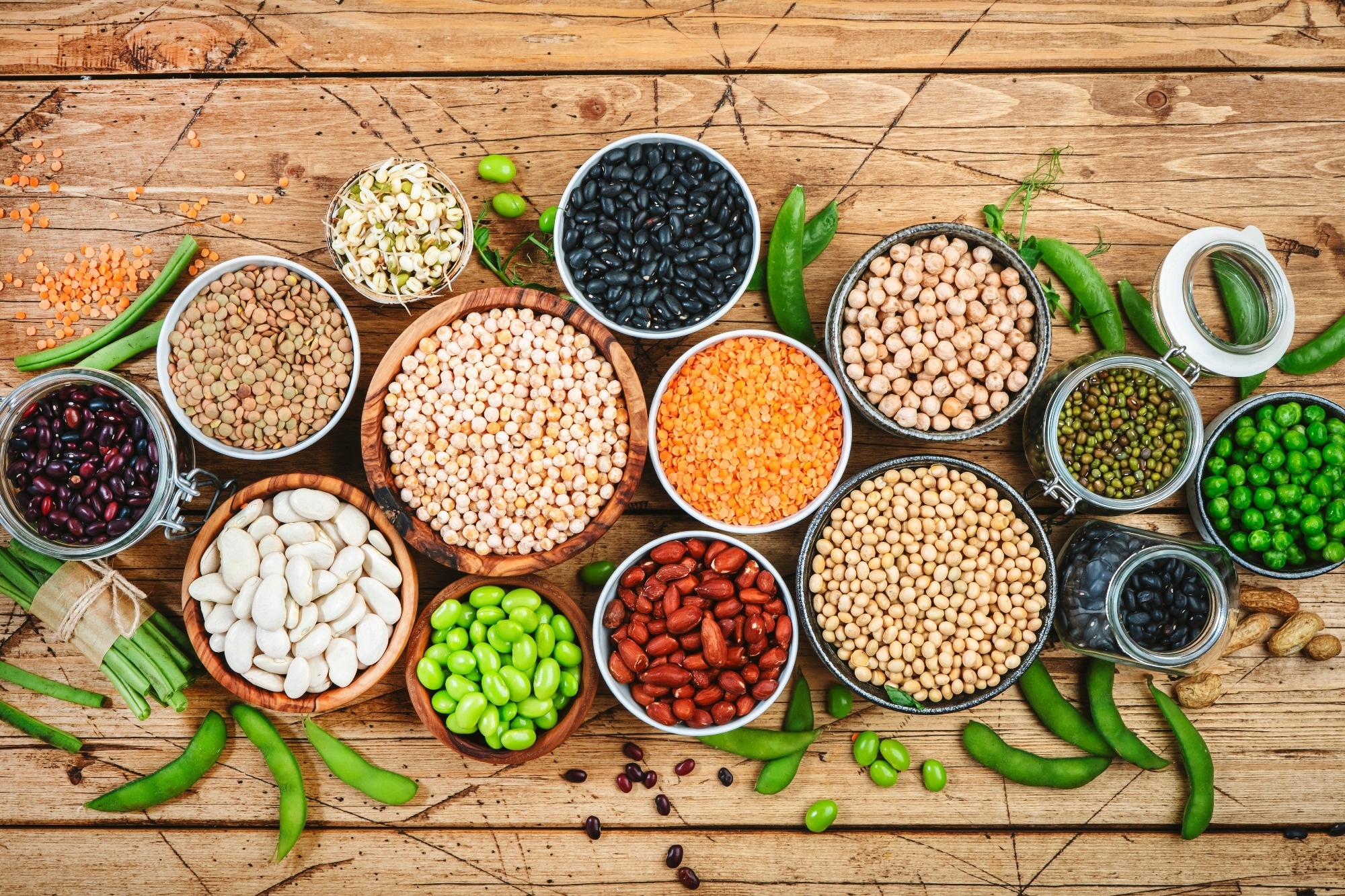 Image Credit: 5PH / Shutterstock.com
Image Credit: 5PH / Shutterstock.com
Is There Such a Thing as Too Much Fiber?
Although fiber is important for health, consuming an excessive amount of fiber or increasing its intake too quickly can lead to digestive discomfort. Symptoms such as gas, bloating, and constipation may occur if fiber is not accompanied by sufficient water intake.
Fiber adds bulk to stool and, without adequate hydration, may slow digestion and cause discomfort. To avoid these effects, researchers recommend gradually adding small portions of high-fiber foods to daily meals, as this approach helps the digestive system adjust and supports a smooth transition to a fiber-rich diet.
References
- Guan, Z. W., Yu, E. Z., & Feng, Q. (2021). Soluble dietary fiber, one of the most important nutrients for the gut microbiota. Molecules, 26(22), 6802. DOI: 10.3390/molecules26226802, https://www.mdpi.com/1420-3049/26/22/6802
- McKeown, N. M., Fahey, G. C., Slavin, J., & Van der Kamp, J. W. (2022). Fibre intake for optimal health: how can healthcare professionals support people to reach dietary recommendations? bmj, 378. DOI: 10.1136/bmj-2020-054370, https://www.bmj.com/content/378/bmj-2020-054370
- Alahmari, L. A. (2024). Dietary fiber influence on overall health, with an emphasis on CVD, diabetes, obesity, colon cancer, and inflammation. Frontiers in Nutrition, 11, 1510564. DOI: 10.3389/fnut.2024.1510564, https://www.frontiersin.org/journals/nutrition/articles/10.3389/fnut.2024.1510564/full
- Fu, J., Zheng, Y., Gao, Y., & Xu, W. (2022). Dietary fiber intake and gut microbiota in human health. Microorganisms, 10(12), 2507. DOI: 10.3390/microorganisms10122507, https://www.mdpi.com/2076-2607/10/12/2507
- Aleid, S., Alshahrani, N. Z., Alsedrah, S., Carvalho, A. B., Lima, M. J., Teixeira-Lemos, E., & Raposo, A. (2024). The role of social media advertisement and physical activity on eating behaviors among the general population in Saudi Arabia. Nutrients, 16(8), 1215. DOI: 10.3390/nu16081215, https://www.mdpi.com/2072-6643/16/8/1215
- Joye, I. J. (2020). Dietary fibre from whole grains and their benefits on metabolic health. Nutrients, 12(10), 3045. DOI:10.3390/nu12103045, https://www.mdpi.com/2072-6643/12/10/3045
Further Reading
Last Updated: Jun 9, 2025